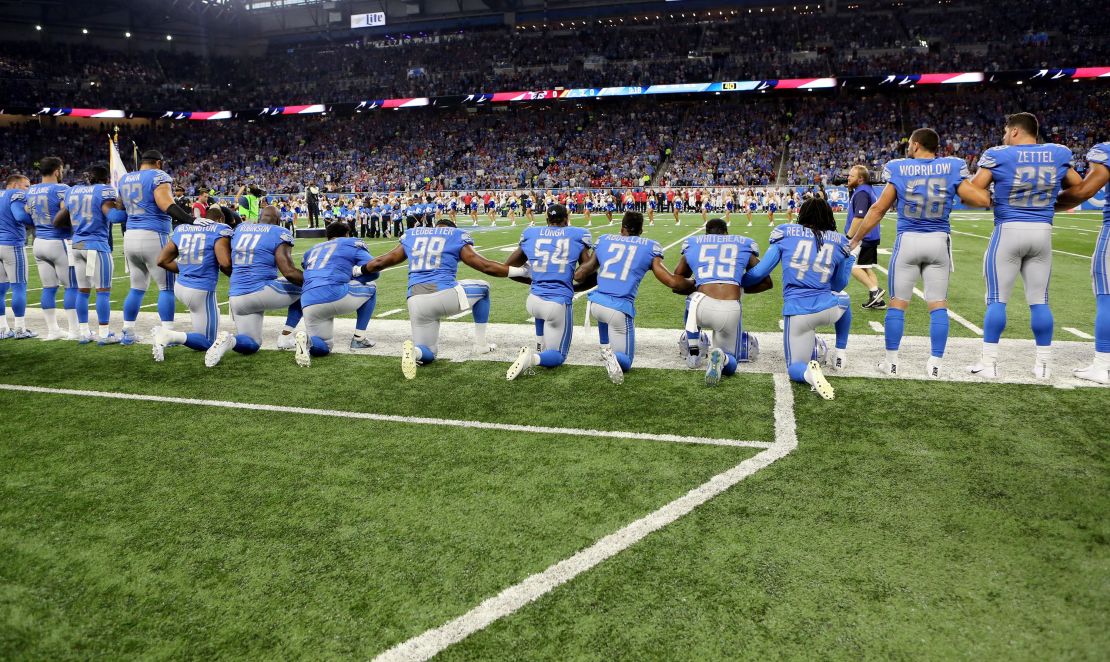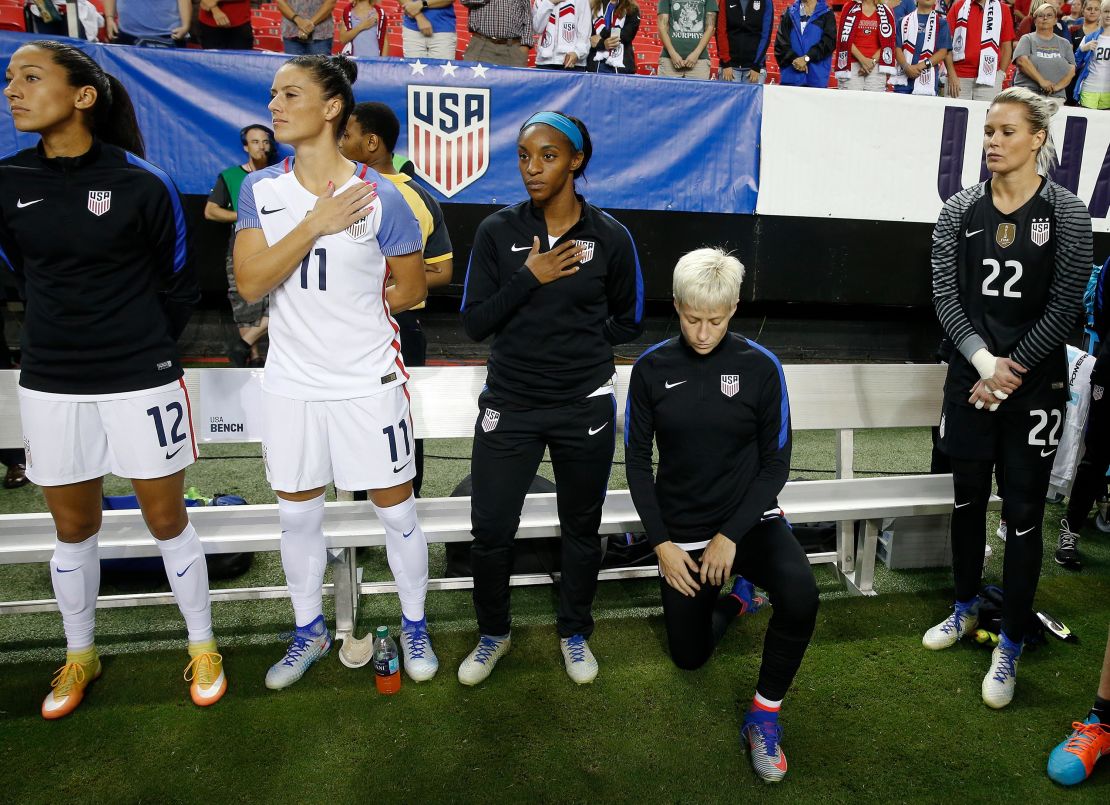A version of this story appeared in CNN’s Race Deconstructed newsletter. To get it in your inbox every week, sign up for free here.
At the end of the first episode of “Colin in Black & White,” Ava DuVernay and Colin Kaepernick’s six-part Netflix docudrama about the former 49er quarterback’s adolescence and rise to fame, Kaepernick doesn’t just summarize his evolution from self-effacing high schooler to political activist – he also nods to his own power.
“I didn’t have the knowledge, wisdom or language to fight back. I couldn’t rebel because I didn’t know how. But now? Now, I know how. And I will,” he says in the series, which arrives on Friday.
Of course, Kaepernick has done more than merely rebel. He’s expanded the scope of protest.
By the start of the 2016 NFL season, Kaepernick had captured the country’s attention by kneeling during the national anthem to point up police brutality and the impunity often enjoyed by the officers who inflict that violence.
“I am not going to stand up to show pride in a flag for a country that oppresses Black people and people of color,” he told the NFL Network’s Steve Wyche. “To me, this is bigger than football, and it would be selfish on my part to look the other way. There are bodies in the street and people getting paid leave and getting away with murder.”
The reactions came swiftly. On the right, Kaepernick’s kneeling sparked visceral anger. Detractors seethed; they misrepresented the football player’s defiance, viewing it as an affront to some gauzy notion of patriotism. Meanwhile, for those sympathetic to Kaepernick’s mission, taking a knee offered a blueprint for how to protest.
Five years on, athletes in the NFL and beyond still reproduce Kaepernick’s gesture, summoning it to oppose the structural forces that imperil so many people’s lives. The journalist Dave Zirin refers to what’s become a mass political movement as “The Kaepernick Effect.”
“‘The Kaepernick Effect’ was not the result of someone else’s protest, but a cause, a catalyst for something far greater,” Zirin explains in his riveting new book, “The Kaepernick Effect: Taking a Knee, Changing the World.” “It was the warning for a future that came to pass after the police murder of George Floyd, coming on the heels of the murders of Ahmaud Arbery and Breonna Taylor. It was the warning that people were poised and ready to fight.”
I spoke with Zirin about how Kaepernick’s kneeling both fits into and stands apart from a storied tradition of athlete activism, and how recent revelations about the deposed Raiders coach Jon Gruden only prove the importance of the football player’s message.
The following conversation has been lightly edited for length and clarity.

You write that Kaepernick and the many other athletes who took a knee between 2016 and 2018 were the “canary in the coal mine” for what we saw in 2020. What do you mean by that?
In the summer of 2020, you had the largest protests in the history of the US. I don’t think that we say that enough when we speak about the summer of 2020. And the protests were all around the same issue, the same outrage, the same atrocity – the police murder of George Floyd. I’d make the case that many roads led us to the summer of 2020, but one of those roads ran straight through the athletic fields of the US.
If you look at the tempo of the Black Lives Matter movement between, say, 2018 and 2020, there had actually been a bit of a lull. And yet during that time, you had hundreds, if not thousands, of young people still taking a knee during the national anthem to protest racial inequity and police violence. This has gone underreported and under-discussed. But every time they took a knee, it sent shock waves through their communities. We’re talking dozens of communities that felt the effect of Kaepernick’s taking that knee, that felt the effect of the Black Lives Matter movement, that felt the effect of the legacy of the killing of Trayvon Martin, who came up over and over again when I talked with young people about why they took a knee.
And I included a section on high school because there’s something so distinct about being a high school student. We all remember what it was like to worry about not fitting in. Anybody who’s ever been an athlete also knows how traumatic it can be not to have the respect of your coach or your teammates, because that’s supposed to be the ultimate clique. To be an outcast among your athletic peers is something that takes a lot of courage – a particular kind of courage that I wanted to highlight and synthesize.
So, that’s what made not just athletes’ protests but also the reaction to their protests the canary in the coal mine. And while we talk about what we saw in 2020, it’s also what we’ve seen in 2021, with the unhinged reaction to so-called critical race theory and even with some of the responses to masking. There’s a section of the US population that believes that violence is an appropriate response to political disagreement and dissent. The mere thought of having deeper discussions about racism is sending people into an utter panic.
Kaepernick’s words, you argue in your book, were different from other athletes’ because other athletes were “calling for peace, whereas Kaepernick was calling for justice.” Tell me a bit more about this subtle yet important distinction.
In the summer of 2016, you had the police killings of Alton Sterling and Philando Castile, and there were lots of responses by athletes. The first sign that the sports world was going to play a big role in what was happening was in the ESPY speech that LeBron James, Carmelo Anthony, Chris Paul and Dwyane Wade gave after the death of Muhammad Ali. If you go back and listen to what they were saying, they were talking about peace. They were talking about the outrages, but they were also saying, “We need to bring the country together. We need to come together as one.”
Then Kaepernick said, “Actually, we can’t talk about coming together until there’s justice.” That represented a big shift in what many athletes had been saying up to that point in terms of looking for quote-unquote solutions. Kaepernick was saying, and all these young people I spoke with were saying, “We can’t even talk about solutions until we address the problem. We can’t be like Jay-Z and say that we’re beyond kneeling, when the issue is still right there in everybody’s face.”
I always liken that shift to Muhammad Ali and his position on the Vietnam War. Ali never said, “We need to get people who love the war and hate the war in one room and learn how to love one other.” He said, “No, there’s a side. And it’s anti-war. There’s right, and there’s wrong. And I know which side I’m on.”

If Kaepernick were to kneel this year, it’d barely be news. But he’s still on the outs, even though the work he did helped to create the better environment that he can’t get back into. What does this tension say about the NFL?
Two very clear things. The first is that NFL ownership has decided that Kaepernick has more value to them as a ghost story than as someone who can contribute to a Super Bowl team. He has more value as somebody they can use to scare young players into staying in line than he does as somebody they think can help. So, I do think that that was part of the calculus in terms of what I think was a very open collusion attempt to keep him out of the sport.
The second thing is that the NFL operates on a system of what I’d describe as racial labor discipline, in that it’s very authoritarian, very top-down and very dependent on Black players deciding to play and not be like, “This is bulls***. We play only three-and-a-half years. We don’t have fully guaranteed contracts. We have next to no opportunity to become executives or coaches.” NFL ownership needs that level of discipline to make sure that this incredibly lucrative sport can actually function on these, I would argue, institutionally and systemically racist grounds.
So, the NFL has no problem putting “End Racism” in the end zone or even having people have “Black Lives Matter” on their helmets, because it’s being orchestrated from the top down. But having someone try to change the way that the NFL operates from the bottom up? That’s a different ballgame.
Last question: What do you make of the Jon Gruden emails?
Just that they kind of prove everything we’ve been talking about. When we speak about these issues being systemic, a lot of times people just roll their eyes. But the Gruden emails actually give us an incredible view into the kind of contempt that people in power in the NFL have for the people whose blood, sweat and tears make the sport. And we should be conscious of that – that this is a league that requires a serious airing out.



